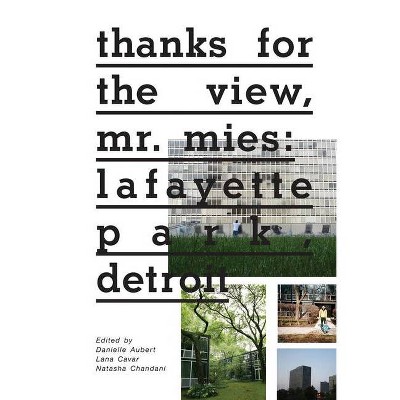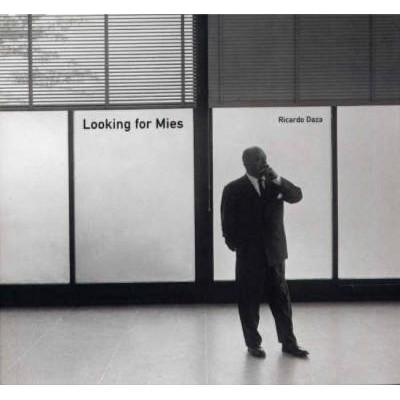Thanks for the View, Mr. Mies - by Danielle Aubert & Lana Cavar & Natasha Chandani (Paperback)

Similar Products
Products of same category from the store
AllProduct info
<p/><br></br><p><b> Book Synopsis </b></p></br></br><p><strong>"This inspiring 288-page volume from Metropolis Books captures the convivial atmosphere the authors found at Detroit's Lafayette Park, a housing development designed by Ludwig Mies van der Rohe ... an intriguing glimpse of how personal style rarely conforms to strict Modernism. -Helena Grdadolnik <i>Azure</i> "See glossy photos of bathroom doorknobs and mail slots, learn more about early community newsletters, whistle with the neighborhood bagpiper. In two words: be amazed." -Sebastian Hofer, <i>The Detroit News</i></strong></p><p>Lafayette Park, a middle-class residential area in downtown Detroit, is home to the largest collection of buildings designed by Ludwig Mies van der Rohe in the world. Throughout the 1990s and 2000s, it remained one of Detroit's most racially integrated and economically stable neighborhoods, although it was surrounded by evidence of a city in financial distress. Through interviews with and essays by residents, reproductions of archival material: new photographs by Karin Jobst, Vasco Roma and Corine Vermeulen, and previously unpublished photographs by documentary filmmaker Janine Debanné, <i>Thanks for the View, Mr. Mies</i>examines the way that Lafayette Park residents confront and interact with this unique modernist environment. This book is a reaction against the way that iconic modernist architecture is often represented. Whereas other writers may focus on the design intentions of the architect, authors Aubert, Cavar and Chandani seek to show the organic and idiosyncratic ways in which the people who live in Lafayette Park actually use the architecture and how this experience, in turn, affects their everyday lives. <i>Thanks for the View, Mr. Mies</i> was originally published in 2012, two years before the city of Detroit entered into the largest municipal bankruptcy in the country. The 2019 edition of Thanks for the View, Mr. Mies includes a revised introduction and two new texts by Lafayette Park residents, and authors, Marsha Music and Matthew Piper. Music and Piper reflect on the changes the neighborhood underwent between 2012 and 2018, when the city went through and emerged from bankruptcy and entered into a new phase, as a desirable place for real estate investment.</p><p/><br></br><p><b> Review Quotes </b></p></br></br><br>Thanks for the View, Mr. Mies explores how Modernist architecture improves lives in the Lafayette Park section of Detroit, which has the world's largest concentration of Mies van der Rohe buildings. (It's also one of the most racially integrated neighborhoods in what might well be America's most segregated city.)-- "T: The New York Times Style Magazine"<br><br>...a fine-grained publication that celebrates Lafayette Park's residents and daily life there. That book conveys a sense of a complex, diverse ecology: from college students and retirees to herons, pheasants, and possums.--Mariana Mogilevich "Public Books"<br><br>Exceptionally informed and informative, this impressive and newly updated study is a seminal work of outstanding scholarship and unreservedly recommended for personal, professional, community, and academic library American Architecture & Urban Development history collections and supplemental studies reading lists.--Julie Summers "Midwest Book Review"<br><br>In their new book, Thanks for the View, Mr. Mies, which is due out at the end of the month (Metropolis Books, $29.95), the editors Danielle Aubert, Lana Cavar and Natasha Chandani, graphic designers all, offer a portrait of Lafayette Park very different from the classic Mies monograph.<br>Contents include interviews with residents of Lafayette Park's towers and town houses; archival materials from the complex's history; an account of nine days spent trying to climate-control a corner apartment; and essays on Mies in Detroit, the Lafayette Park landscape, bird-watching and a record of bird-strike deaths (birds and plate glass don't mix).<br>At-home portraits of residents by Corine Vermeulen show Mies's architecture as a strong frame for personal expression. Some homes look like shrines to 1958, while others reflect the lived-in décor of decades. Jacqueline Neal, an interior designer and 12-year resident of the Pavilion, the smallest of the complex's three towers, spoke last month about living and accessorizing with Mies.--Alexandra Lange "The New York Times, Home Section"<br><br>Thanks to a master plan by architect Mies van der Rohe, urban planner Ludwig Hilbersheimer, landscape architect Alfred Caldwell and the spirit of its residents, the neighborhood turned out to be one of the most successful communities in Detroit.<br>Or, as essayist Marsha Music, who lives in one of the 183 town-houses of Lafayette Park, puts it: The peace here may be a reward, bequeathed through the ages, for having the commitment and audacity to maintain an integrated community in one of the most segregated cities in the United States. God is certainly in these details, as Mies might say.<br>It's the prime achievement of Thanks for the View, Mr. Mies to show those details in all their significance, and to show them in a very clever and never all too earnest way. See glossy photos of bathroom doorknobs and mail slots, learn more about early community newsletters, whistle with the neighborhood bagpiper.<br>In two words: Be amazed.--Sebastian Hofer "The Detroit News"<br><br>The second edition of a unique book on Lafayette Park illustrates what's different and what's the same about the Mies van der Rohe-designed neighborhood.--Aaron Mondry "Curbed"<br><br>This inspiring 288-page volume from Metropolis books captures the convivial atmosphere the authors found at Detroit's Lafayette Park, a housing developement designed by Ludwig Mies van der Rohe that encompasses 32 hectares of towers, townhouses and parks. I visited the area 15 years ago, the book took me right back to its quiet streets, green spaces and distinctive glass and steel design. The three editors (also the book's graphic designers) bring Layfayette to life, primarily through interviews with residents and photographs of them in their apartments. The images provide an intruiging glimpse of how personal style rarely conforms to strict Modernism.--Helena Grdadolnik "Azure"<br>
Price History
Price Archive shows prices from various stores, lets you see history and find the cheapest. There is no actual sale on the website. For all support, inquiry and suggestion messagescommunication@pricearchive.us




















